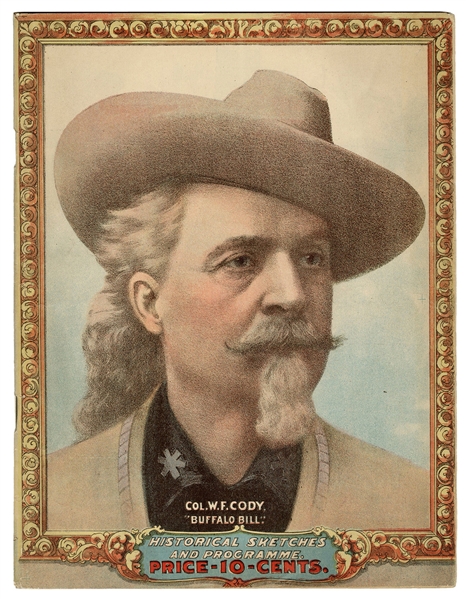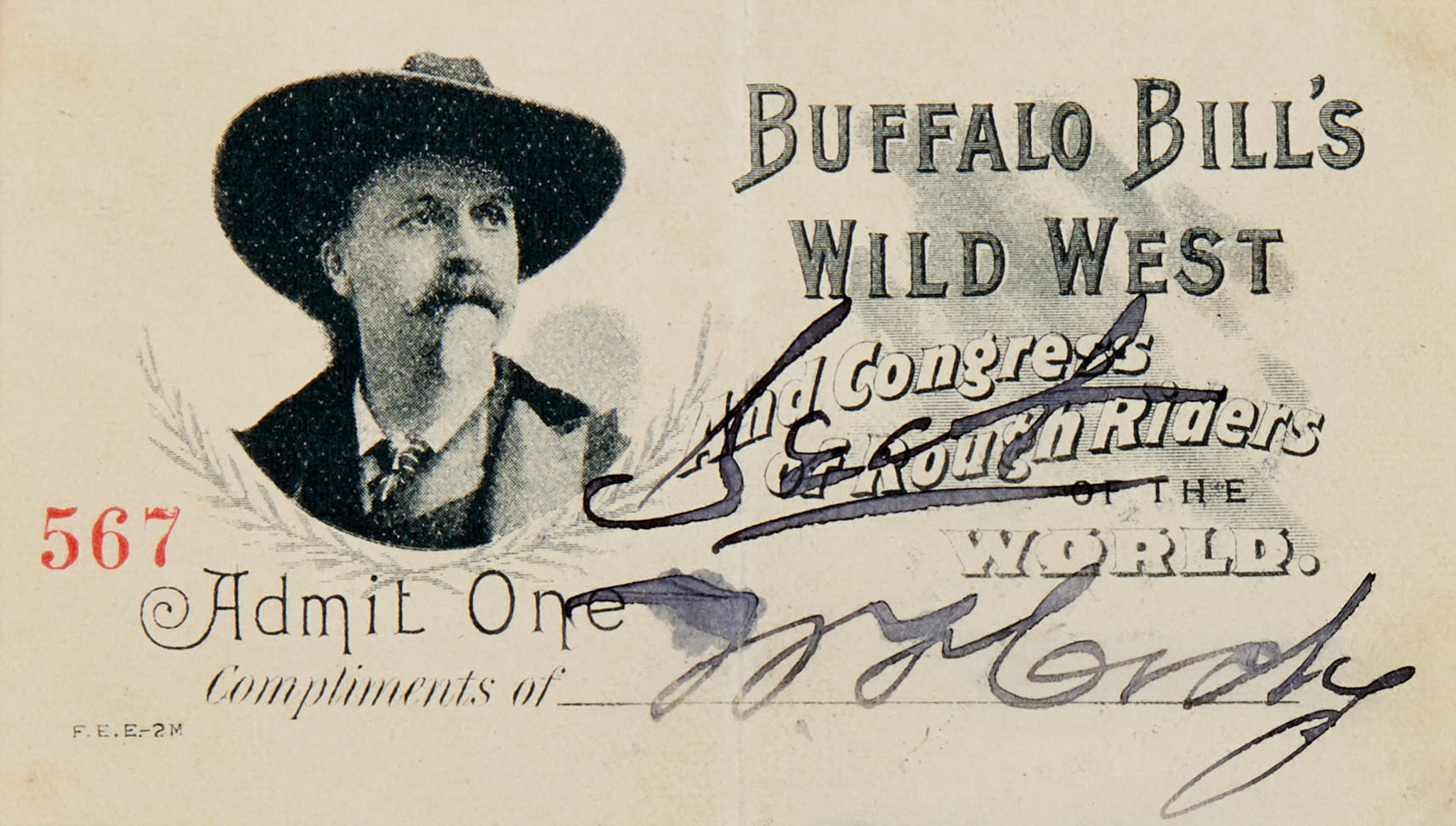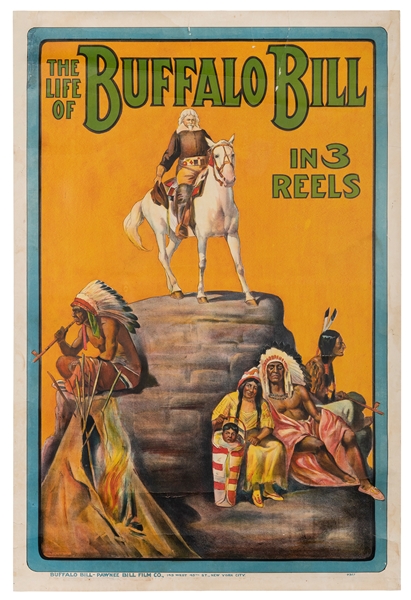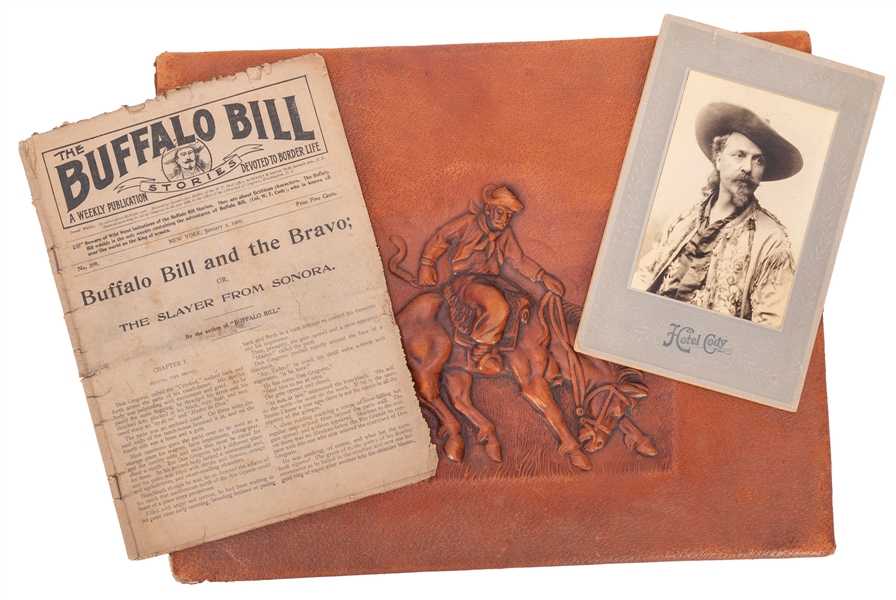William F. "Buffalo Bill" Cody (1846-1917). Autograph letter signed ("Col") to Irving R. Bacon. Birmingham, [England], June 9 [1903]. 2pp, 4.5 x 7 in., on gilt Buffalo Bill's Wild West Pahaska Tepeé with gilt buffalo letterhead, minor even toning. Irving R. Bacon (1875-1962) was one of the many artists who contributed illustrations to W.F. Bayer and O.F. Keydel's history of the Congressional Medal of Honor, Deeds of Honor. Bacon's interpretation and composition of Cody's action which earned him the Medal in 1872 impressed the western showman and inspired him to commission a painted version from the artist in 1901. Bacon delivered the completed painting Buffalo Bill in Pursuit, or Two with One Shot in the spring of 1902 where Cody was in New York preparing for the 1902 season. This meeting was the start of a fruitful working relationship between the two men with Bacon helping to visually cement Cody's western self-presentation. In December 1902, Cody and Bacon had discussed the creation of a painting of Cody's July 17, 1876 duel with Cheyenne warrior Yellow Hand at Warbonnet Creek. Cody left to tour Europe, and the two corresponded about the details of the painting. In this letter written while on tour in Birmingham, Cody amusingly reveals what he was wearing on the day of the famed encounter: "Yes I had on the day I killed Yellow Hand a showy Mexican dress. One I had worn when playing a Mexican part on the Stage." He quickly instructs Bacon on how he would wish to be depicted: "But for the painting I would prefer Buckskins." Cody continues on with further minutiae: "Yellow Hand wore buckskin leggins & mockisans [sic], no shirt. He shot with a Remington six shooter. My saddle was Cowboy. I shot him with a Winchester. But when my horse fell I lost it, and finished him with my knife. Everything was done quickly, lots of action." In Irving's finished painting, The Killing of Yellow Hand now in the collection of the Buffalo Bill Center of the West, the events of the battle are essentialized and the singular focus of the painting is the combatants. The composition is dominated by Cody and Yellow Hand, each on horseback, in a shallow valley of scrubland. Yellow Hand, wearing a feathered war bonnet struggles to maintain control of his falling horse, Cody fires his Winchester atop a white steed as described in this letter by Cody. The large groups of combatants on both sides that Cody describes in an earlier letter (see Lot ##) who were present at the real skirmish are relegated to the far horizons. The scalping of the Cheyenne chief which occurred at the real duel is also eliminated. This was one of the first engagements after Custer's defeat at Little Big Horn, and was often referred to as the "First Scalp for Custer," here Buffalo Bill claims he shouted the vengeful words and held the scalp high. Bacon, however, expressed deep reservations in a return letter and later Cody agreed that it "might look bad to some people." The oil on canvas was completed in 1906, but Cody appears to have never took possession of it perhaps due to lack of funds to pay Bacon, a somewhat persistent problem (see Lot ##). The public was first able to see the work when Cody used it to illustrate a chapter in his 1908 autobiography True Tails of the Plains, where he also eschews mention of the scalping in his narrative.
William F. "Buffalo Bill" Cody (1846-1917). Autograph letter signed ("Col") to Irving R. Bacon. Birmingham, [England], June 9 [1903]. 2pp, 4.5 x 7 in., on gilt Buffalo Bill's Wild West Pahaska Tepeé with gilt buffalo letterhead, minor even toning. Irving R. Bacon (1875-1962) was one of the many artists who contributed illustrations to W.F. Bayer and O.F. Keydel's history of the Congressional Medal of Honor, Deeds of Honor. Bacon's interpretation and composition of Cody's action which earned him the Medal in 1872 impressed the western showman and inspired him to commission a painted version from the artist in 1901. Bacon delivered the completed painting Buffalo Bill in Pursuit, or Two with One Shot in the spring of 1902 where Cody was in New York preparing for the 1902 season. This meeting was the start of a fruitful working relationship between the two men with Bacon helping to visually cement Cody's western self-presentation. In December 1902, Cody and Bacon had discussed the creation of a painting of Cody's July 17, 1876 duel with Cheyenne warrior Yellow Hand at Warbonnet Creek. Cody left to tour Europe, and the two corresponded about the details of the painting. In this letter written while on tour in Birmingham, Cody amusingly reveals what he was wearing on the day of the famed encounter: "Yes I had on the day I killed Yellow Hand a showy Mexican dress. One I had worn when playing a Mexican part on the Stage." He quickly instructs Bacon on how he would wish to be depicted: "But for the painting I would prefer Buckskins." Cody continues on with further minutiae: "Yellow Hand wore buckskin leggins & mockisans [sic], no shirt. He shot with a Remington six shooter. My saddle was Cowboy. I shot him with a Winchester. But when my horse fell I lost it, and finished him with my knife. Everything was done quickly, lots of action." In Irving's finished painting, The Killing of Yellow Hand now in the collection of the Buffalo Bill Center of the West, the events of the battle are essentialized and the singular focus of the painting is the combatants. The composition is dominated by Cody and Yellow Hand, each on horseback, in a shallow valley of scrubland. Yellow Hand, wearing a feathered war bonnet struggles to maintain control of his falling horse, Cody fires his Winchester atop a white steed as described in this letter by Cody. The large groups of combatants on both sides that Cody describes in an earlier letter (see Lot ##) who were present at the real skirmish are relegated to the far horizons. The scalping of the Cheyenne chief which occurred at the real duel is also eliminated. This was one of the first engagements after Custer's defeat at Little Big Horn, and was often referred to as the "First Scalp for Custer," here Buffalo Bill claims he shouted the vengeful words and held the scalp high. Bacon, however, expressed deep reservations in a return letter and later Cody agreed that it "might look bad to some people." The oil on canvas was completed in 1906, but Cody appears to have never took possession of it perhaps due to lack of funds to pay Bacon, a somewhat persistent problem (see Lot ##). The public was first able to see the work when Cody used it to illustrate a chapter in his 1908 autobiography True Tails of the Plains, where he also eschews mention of the scalping in his narrative.















Testen Sie LotSearch und seine Premium-Features 7 Tage - ohne Kosten!
Lassen Sie sich automatisch über neue Objekte in kommenden Auktionen benachrichtigen.
Suchauftrag anlegen